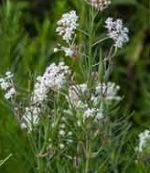 Also known as horsetail milkweed, this deep rooted herbaceous perennial is a member of the dogbane family, Apocynaceae, that also includes bluestar, periwinkle,and oleander. It is native to North America from Massachusetts and Saskatchewan south to Florida and Arizona where it grows in pastures, fields, prairies, meadows, open woods, and roadsides. Plants grow 1- 3′ tall and have unbranched stems carrying needle-like leaves 2-3″ long. The leaves have rolled margins and are arranged in whorls of 3 to 6 at the closely spaced nodes. They turn yellow at the end of the season and provide color to the fall garden. In mid to late summer, small, fragrant, greenish-white flowers appear in flat-topped clusters in the upper leaf axils. Each cluster is 3/4-1 3/4″” across and contains 3 to 20 flowers. The flowers are 1/4″ long and have 5 petals with hoods bearing incurved horns. Fruits are narrow pods up to 3″ long and contain silky-tailed seeds. Plants spread by seed and rhizomes and can be too vigorous for small or formal gardens if unrestrained. They are valued, however, in natural gardens as well as perennial borders, butterfly gardens, cottage gardens, and roadside restoration projects. Butterflies, particularly monarchs, need the plant for survival. On the other hand, all parts of the plant are toxic in large quantities and are especially dangerous for livestock. The pods are valued for dried arrangements. The genus name, Asclepias, is the name of the Greek good of medicine. The specific epithet, verticillata, comes from the Latin word, verticillus, meaning whorl, and refers to the arrangement of the leaves. The common name, milkweed, refers to the milky sap contained in the stem.
Also known as horsetail milkweed, this deep rooted herbaceous perennial is a member of the dogbane family, Apocynaceae, that also includes bluestar, periwinkle,and oleander. It is native to North America from Massachusetts and Saskatchewan south to Florida and Arizona where it grows in pastures, fields, prairies, meadows, open woods, and roadsides. Plants grow 1- 3′ tall and have unbranched stems carrying needle-like leaves 2-3″ long. The leaves have rolled margins and are arranged in whorls of 3 to 6 at the closely spaced nodes. They turn yellow at the end of the season and provide color to the fall garden. In mid to late summer, small, fragrant, greenish-white flowers appear in flat-topped clusters in the upper leaf axils. Each cluster is 3/4-1 3/4″” across and contains 3 to 20 flowers. The flowers are 1/4″ long and have 5 petals with hoods bearing incurved horns. Fruits are narrow pods up to 3″ long and contain silky-tailed seeds. Plants spread by seed and rhizomes and can be too vigorous for small or formal gardens if unrestrained. They are valued, however, in natural gardens as well as perennial borders, butterfly gardens, cottage gardens, and roadside restoration projects. Butterflies, particularly monarchs, need the plant for survival. On the other hand, all parts of the plant are toxic in large quantities and are especially dangerous for livestock. The pods are valued for dried arrangements. The genus name, Asclepias, is the name of the Greek good of medicine. The specific epithet, verticillata, comes from the Latin word, verticillus, meaning whorl, and refers to the arrangement of the leaves. The common name, milkweed, refers to the milky sap contained in the stem.
Type: Herbaceous perennial
Bloom:Flat top clusters of greenish white flowers from mid to late summer
Size: 2-3′ H x 2-3′ W
Light:Full sun to part shade
Soil: Average, dry to medium moist, well-drained; drought resistant when established
Hardiness: Zones 4-9
Care: Low maintenance
Pests and Diseases: Aphids
Propagation: Seed, division
Companion Plants: Liatris aspera, Echinacea, Coreopsis tripteris, Rudbeckia hirta,, short ornamental grasses